产品伤害危机对品牌资产的影响ppt
- 格式:pptx
- 大小:2.90 MB
- 文档页数:26
![产品伤害危机对品牌绩效指标的影响[外文翻译]](https://uimg.taocdn.com/df5c7a8351e79b8968022640.webp)
毕业论文(设计)外文翻译一、外文原文标题:The effects of product-harm crisis on brand performance原文:IntroductionThe term ‘product-harm crisis’ refers to well-known events related to product defects or harm associated with some brands (Siomkos & Kurzbard 1994). For example, in 2000, when news spread that more than 100 people had died in accidents involving defective Firestone tyres, the company had to recall millions of its products (Advertising Age 2000). In September 2008, 6244 babies in China were diagnosed as suffering from numerous ailments after ingesting the poisonous Sanlu formula (People Daily 2008). Having used all of its cash reserves for product recall and medical payments, Sanlu Company was declared bankrupt in 2009. In 2005, NestléCompany mistakenly sold milk powder that contained more iodine than Chinese national standards permit in the market. When the news broke, Nestlé had to make a public apology and remove the defective product from shelves (ABC News 2005). After this crisis, in an effort to restore reduced sales, Nestlégave out samples and stationed doctors in Beijing supermarkets to deal with customers’ concerns.These examples clearly suggest that a product-harm crisis can seriously imperil a brand’s performance - and even totally destroy a company, as in the case of Sanlu. Therefore, understanding how a product-harm crisis influences brands and the market structure is of great practical and theoretical interest.The NBD-Dirichlet model (Ehrenberg 1988) is a well-established statistical model and has been extensively used to audit and predict brand performance measures (BPMs) under stationary and dynamic market structures (Ehrenberg et al. 2004). However, this model has not been used to analyse the influence of product-harm crises. Since a product-harm crisis can greatly affect brand performance, it is reasonable to assume that, by monitoring the BPMs through the product-harm crisis,we can indirectly observe how a product-harm crisis influences brands and the market structure of this product category. This approach should provide some practical benefits from a new perspective.Our main objective in this paper is to use the NBD-Dirichlet model to monitor the leading brands’ BPMs during the 2005 Nestlé product-harm crisis that occurred in China. By comparing the observed BPMs of the pre-, during and post-crisis periods to those expected, and looking at the differences between these three periods, we may come to understand how a product-harm crisis influences brands (including both crisis brand and non-crisis brands) and market structure. Limitations and managerial implications are discussed.The product-harm crisis and its influence on the brandAfter a series of product-harm crises over the years, related studies have been developed in a number of research fields. It has been widely accepted that product-harm crises have a negative influence on crisis-brand equity (Heerde et al. 2007). For example, a brand under crisis may lose its baseline sales and become more sensitive to a competitor’s market activit ies (Heerde et al. 2007). The crisis may also affect the crisis brand’s stock price (Salin & Hooker 2001). Compared to limited systematic research into crises’ market sequences, past research has focused on consumers’ and firms’ reaction towards such crise s (Dawar & Pilluta 2000).Depending on how it is conducted, most research in connection with product-harm crises can be classified into three categories. The first consists of descriptive checklists suggesting which strategies work or do not work in terms of business practices (Mitroff 2004). Because this kind of research cannot quantify the damage incurred, it can only provide limited guidance for understanding the underlying mechanisms of product-harm crises. Another stream of such research focuses on laboratory experiments. Equipped with psychological theories and different control variables, this kind of research can help us understand the moderators that play a part in influencing a product-harm crisis’s effects, and perhaps provides some valuable insights (Dawar & Pilluta 2000; Vassilikopoulou et al. 2009). However, external validity is one limitation of such research.Another research stream has recently grown in popularity, where panel data gathered during real product-harm crises have been collected and analysed using advanced mathematical models (Heerde et al. 2007; Cleeren et al. 2008). How the crisis influences the performance of the crisis brand or the affected product category can be tracked by monitoring the brand’s stock price (Salin & Hooker 2001) or sales (Heerde et al. 2007). By all accounts, this research stream provides more practical insights about the influence of the product-harm crisis.This study contributes to the third research stream in that we used the NBD-Dirichlet model to quantify the product-harm crisis’s effect on BPMs (including penetration, market share, purchase frequency and share of category requirement) and market structure during the 2005 Nestlé milk powder crisis.DiscussionThis study focused on the Nestlémilk powder crisis that occurred in China in 2005. Based on panel data from 336 families in the Beijing area, we studied the effects of a product-harm crisis on brands and market structure using the NBD-Dirichlet model. We found, first, that the market structure in the pre-crisis period was stationary. The product-harm crisis disturbed the balance, and the market during the crisis was no longer steady. As a consequence, the predictions of purchase frequencies and SCRs were not consistent with the observed measures. Four months after the outbreak of the crisis, the overall market was still not back to stationary status and there were some deviations of SCRs and purchase frequencies. This indicates that the crisis’s influence on the market still existed, and it might last for some time. However, it is interesting to point out that the observed market share and penetration seemed to match the predicted measures in all three periods. When the market was not steady in the during-crisis and the post-crisis periods, detailed data show that in most situations the observed purchase frequencies (Mengniu and Wondersun) or SCRs (Nestlé) were significantly lower than the estimated measures. This may indicate that Mengniu and Wondersun acquired some new customers from Nestlé, and these new customers did not commit heavy purchases to these brands. (This is explained in more detail in the following paragraph.) Our data also show that,among those non-crisis brands, Yili was an exception, with higher than expected SCR in both the during and post-crisis periods. In addition, the observed purchase frequencies of Yili in the during and post-crisis periods were always greater than the predicted measures, even though the difference was less than 0.3. This may relate to its market position: in both periods, Yili had the highest market share, with more than 3% margin, while its penetration was similar to that of its competitors.Second, a product-harm crisis hurts the crisis brand greatly. Our data clearly showed that the market share and penetration of Nestlé dropped significantly during the product crisis. Even though these measures recovered during the post-crisis period, they were still significantly lower than their pre-crisis levels. On the other hand, those non-crisis brands benefited from this crisis with significantly higher penetration, although our data also show a trend of returning to their pre-crisis levels. The decreased market share of Nestléredistributed to all other brands (more than 70 brands), and each of them took only a part of it. Therefore, no significant change of market share was seen in the non-crisis brands.Third, the crisis’s influence on purchase frequency and SCR of the crisis brand was not significantly different from those of the non-crisis brands. In terms of pu rchase frequency, this similarity lies in two aspects: in all three periods, Nestlé’s relative purchase frequency was always the same (significantly lower than Yili but marginally higher than the other two brands); and during the transition from the pre-crisis period to the post-crisis period, all four leading brands dropped by around0.3. Similarly, the observed SCRs of Nestlé, Mengniu and Wondersun all experienceda similar drop from the pre-crisis period to the during-crisis period, and recovered to some extent in the post-crisis period. Previous research shows that new brands garnered customer loyalty immediately after they were introduced (Ehrenberg & Goodhardt 2001). Our data further show that even a product-harm crisis will not hurt the crisis brand’s customer loyalty.Overall, Nestlé’s penetration and market share decreased dramatically, while other brands experienced an increase in penetration at the same time. Associated with this transition, the purchase frequencies and SCRs of most leading brands droppedsignificantly. Combining these observations, one reasonable explanation can be given. The product-harm crisis drove some of Nestlé’s customers away to other brands. These switched customers did not form stable purchase behaviour – in other words, they did not limit their purchases to any one special brand. These switched customers were somehow like ‘change-of-pace’ customers (Kahn et al. 1988). Even though the non-crisis brands attracted some new customers and increased their market share or penetration, the average loyalty of their new customer group was low. As a result, their purchase frequencies or SCRs became even lower. This combination of higher penetration and lower loyalty is similar to what happens to change-of-pace brands (Kahn et al. 1988) or to normal brands under deep price cuts (Bhattacharya et al. 1996).Finally, we may need to pay particular attention to Yili. Yili was special in many aspects. First, it always had the highest market share in all three periods. Second, in both the during and post-crisis periods, its observed SCRs were significantly higher than the estimated SCRs. Third, its observed SCR increased from the pre-crisis period to the during-crisis period, while all the other brands experienced SCR drop. Fourth, its observed purchase frequency always led the market with a significant margin. All these may relate to one fact – that Yili was the biggest brand in the pre-crisis market. Our research indicated that, even though all non-crisis brands benefited from Nestlé’s crisis, different brands gained differently; the most dominant brand gained more in terms of market share, even increasing SCR, while the smaller brands had smaller gains in market share and also had to sacrifice SCR. This looks like another ‘double jeopardy’ sma ller brands may have to face in reality. Interestingly, according to Heerde et al. (2007), smaller brands are more damaged than bigger brands after a product-harm crisis. Our research is consistent with that of Heerde et al. (2007) in supporting that it is always good to be a bigger brand and it is always bad to be a smaller brand.ConclusionTo the best of our knowledge, this study is one of the first attempts to apply the NBD-Dirichlet model to investigate the effects of a product-harm crisis. This paperprovides a methodology by which to assess the impact of a product crisis in a quantitative way, and applies the model to a product-harm crisis for Nestlémilk powder in the Chinese market. The research shows that this model is a great tool by which to monitor or track the development of a product-harm crisis. The modelling and estimation processes are straightforward, and the required data can easily be collected. Using this model helps us to monitor the crisis’s influence on the crisis brand, non-crisis brands and even the entire category market.Our research shows that a product-harm crisis can greatly damage the crisis brand’s market share and penetration. However, purchase frequency and SCR were not damaged at similar levels. These combined data indicate that the market was not steady, and a product crisis changed customers’ purchase behaviours. More specifically, a product-harm crisis drove away some customers of the crisis brand and these switched customers did not make up their minds about which brand to eventually switch to. The periods during and after the crisis were critical to both of the crisis brands and non-crisis brands. For crisis brands, they need to maximise their efforts to attract back this group of customers before they commit to other brands. However, for non-crisis brands, even though they had improved their market share and expanded their customer base, they should realize that this is just a temporary improvement. They need to try their best to keep these new customers satisfied, and eventually make them loyal customers. Their strategies and practices during this period will eventually affect whether they can keep these new customers.出处:Baolong Ma,Lin Zhang,Fei Li and Gao Wang.The effects of product-harm crisis on brand performance[J].International Journal of Market Research.2010.52(4), pp.443-458标题:产品伤害危机对品牌绩效指标的影响译文:介绍产品伤害危机就是一些品牌产品因存有缺陷或有害而广为人知的事件(Siomkos和Kurzbard 1994)。
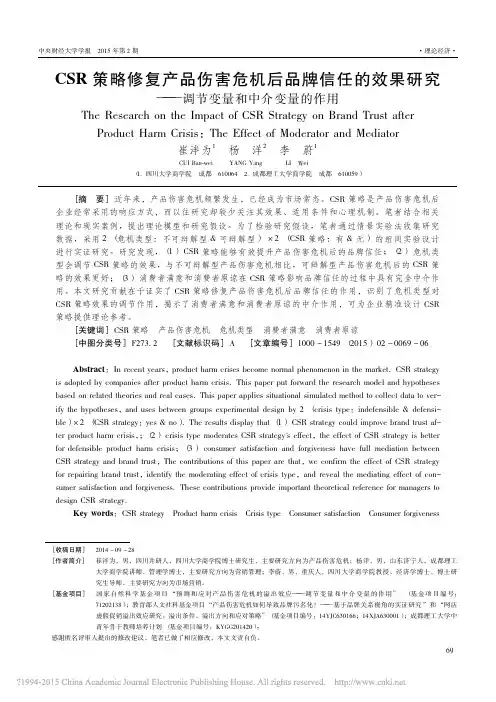
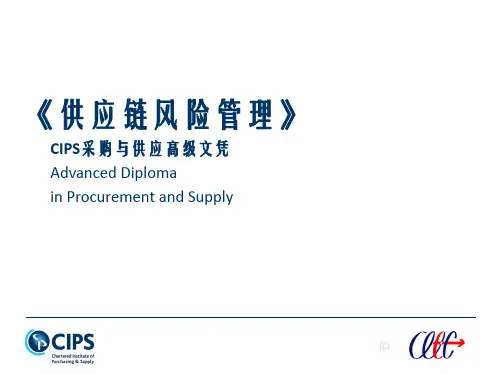
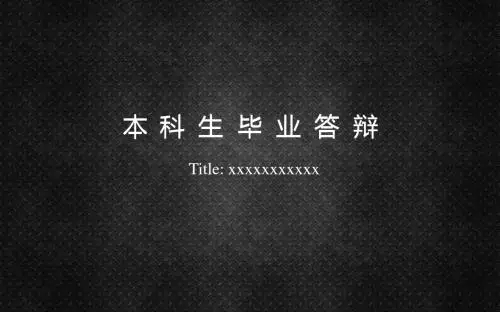
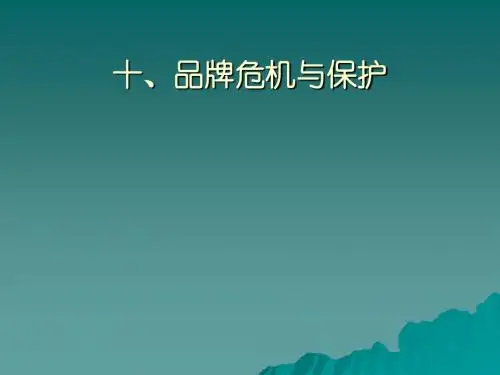
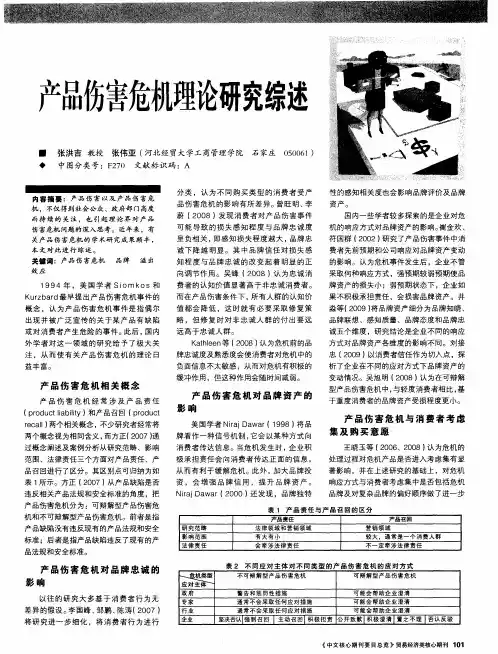

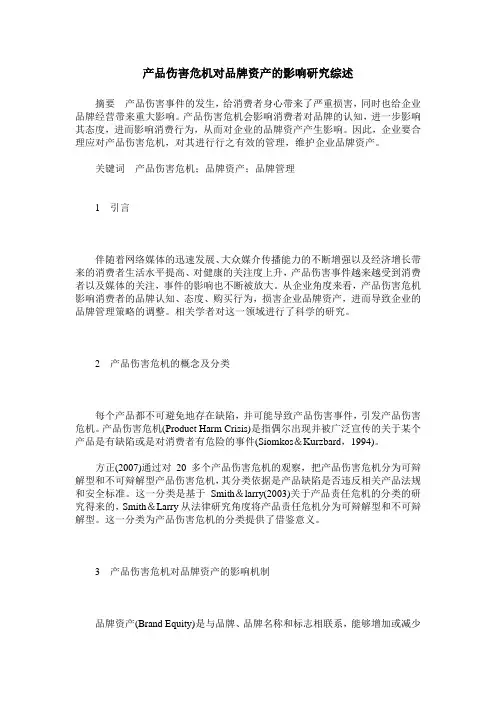
产品伤害危机对品牌资产的影响研究综述摘要产品伤害事件的发生,给消费者身心带来了严重损害,同时也给企业品牌经营带来重大影响。
产品伤害危机会影响消费者对品牌的认知,进一步影响其态度,进而影响消费行为,从而对企业的品牌资产产生影响。
因此,企业要合理应对产品伤害危机,对其进行行之有效的管理,维护企业品牌资产。
关键词产品伤害危机;品牌资产;品牌管理1引言伴随着网络媒体的迅速发展、大众媒介传播能力的不断增强以及经济增长带来的消费者生活水平提高、对健康的关注度上升,产品伤害事件越来越受到消费者以及媒体的关注,事件的影响也不断被放大。
从企业角度来看,产品伤害危机影响消费者的品牌认知、态度、购买行为,损害企业品牌资产,进而导致企业的品牌管理策略的调整。
相关学者对这一领域进行了科学的研究。
2产品伤害危机的概念及分类每个产品都不可避免地存在缺陷,并可能导致产品伤害事件,引发产品伤害危机。
产品伤害危机(Product Harm Crisis)是指偶尔出现并被广泛宣传的关于某个产品是有缺陷或是对消费者有危险的事件(Siomkos&Kurzbard,1994)。
方正(2007)通过对20多个产品伤害危机的观察,把产品伤害危机分为可辩解型和不可辩解型产品伤害危机,其分类依据是产品缺陷是否违反相关产品法规和安全标准。
这一分类是基于Smith&larry(2003)关于产品责任危机的分类的研究得来的,Smith&Larry从法律研究角度将产品责任危机分为可辩解型和不可辩解型。
这一分类为产品伤害危机的分类提供了借鉴意义。
3产品伤害危机对品牌资产的影响机制品牌资产(Brand Equity)是与品牌、品牌名称和标志相联系,能够增加或减少企业所销售产品或服务的价值的一系列资产与负债,主要包括5个方面,即品牌忠诚度、品牌认知度、品牌感知质量、品牌联想、其他专有资产(如商标、专利、渠道关系等)(D,A,Aaker,1991)。
Keller(1993)把品牌资产定义为“因顾客的品牌知识而引起的对该品牌营销活动不同的反应”,即品牌资产的产生是基于消费者头脑中对该品牌的认识。
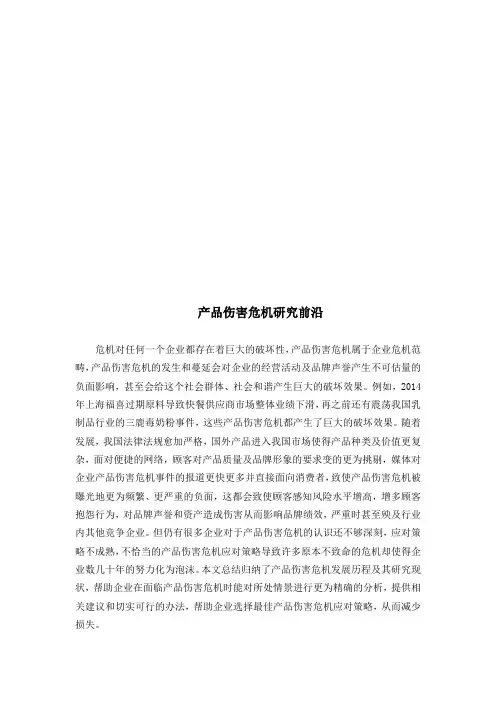
产品伤害危机研究前沿危机对任何一个企业都存在着巨大的破坏性,产品伤害危机属于企业危机范畴,产品伤害危机的发生和蔓延会对企业的经营活动及品牌声誉产生不可估量的负面影响,甚至会给这个社会群体、社会和谐产生巨大的破坏效果。
例如,2014年上海福喜过期原料导致快餐供应商市场整体业绩下滑,再之前还有震荡我国乳制品行业的三鹿毒奶粉事件,这些产品伤害危机都产生了巨大的破坏效果。
随着发展,我国法律法规愈加严格,国外产品进入我国市场使得产品种类及价值更复杂,面对便捷的网络,顾客对产品质量及品牌形象的要求变的更为挑剔,媒体对企业产品伤害危机事件的报道更快更多并直接面向消费者,致使产品伤害危机被曝光地更为频繁、更严重的负面,这都会致使顾客感知风险水平增高,增多顾客抱怨行为,对品牌声誉和资产造成伤害从而影响品牌绩效,严重时甚至殃及行业内其他竞争企业。
但仍有很多企业对于产品伤害危机的认识还不够深刻,应对策略不成熟,不恰当的产品伤害危机应对策略导致许多原本不致命的危机却使得企业数几十年的努力化为泡沫。
本文总结归纳了产品伤害危机发展历程及其研究现状,帮助企业在面临产品伤害危机时能对所处情景进行更为精确的分析,提供相关建议和切实可行的办法,帮助企业选择最佳产品伤害危机应对策略,从而减少损失。
已有研究大多集中在产品伤害危机应对策略,本文的创新之处在于基于不同类型的产品伤害危机来探索其对应的应对策略,把危机进行分类具备更精准的参考价值。
此外以品牌资产为因变量,探索不同应对策略的修复效果。
本文的创新之处在于探讨了调节产品伤害危机负面影响的因素,帮助企业对症下药,同时为学术界提供了一个新的研究思路。
一、产品伤害危机及分类(一)产品伤害危机的定义产品伤害危机是指偶尔出现并被广泛宣传的关于某个产品是有缺陷或是对消费者有危险的事件(Simokos和Kurzbard,1994),这是国内学术界最多引用的概念。
例如,“三聚氰胺毒奶粉危机”、“巨能钙含致癌双氧水危机”和“光明出售回炉牛奶危机”等危机都属于产品伤害危机。